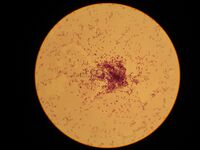Lactococcus lactis
| Lactococcus lactis | ||||||||||||||
|---|---|---|---|---|---|---|---|---|---|---|---|---|---|---|
 | ||||||||||||||
| Scientific classification | ||||||||||||||
| ||||||||||||||
| Binomial name | ||||||||||||||
| Lactococcus lactis |
Lactococcus lactis is a non pathogenic, gram-positive bacteria known as one of the most important microbes in dairy food production. It is closely related to the streptococcus genus and has two subspecies, L. lactis subsp. and L. cremoris subsp. They are used to make soft and hard cheese respectively. L. Lactis group in pairs or short chains with a length of about 1.5µm. Lactococcus are immotile, nonsporelating, and are usually spherical or ovoid cells.
L. Lactis is the starter culture for the production of fermented dairy products such as milk, cheese and yogurt. Lactococcus is considered a opportunistic pathogen, because of its ability to convert almost all of its sugar into lactic acid. Lactic acid produced by the the microbe curdles the milk which separates into curds and in turn is used to produce cheese and whey.
In nature, L. lactis is found to be inactive on plant surfaces and on to multiply in the gastrointestinal tract after being swallowed by an animal.
Genome structure
L. lactis' genome has been sequenced to investigate, what specificly, is its essential role in dairy fermentation. Unexpected features of the analyzed genome have been disclosed, genes are seen to enable the bacterium to perform aerobic respiration along with horizontal gene transfer by transformation. Decades of research has been attributed to the genome sequencing and comparative genomics of L. lactis to unveil the characteristics of L.lactis that can specifically develop flavor, and improve quality and preservation of dairy products such as cheese.
L. lactis is a circular chromosome, its genome contains 2,365,589 base pairs. Protein-coding genes represent 86% of the genome, stable RNA 1.4%, and noncoding regions 12.6%. These percentages are very similar to other bacteria genome. Biological functions have been assigned to 64% of the genome, 20.1% have similar genome to other unknown proteins, however, 15% of the genome is unidentifiable. This 15% is hypothesized to contain the traits specific to L.lactis.
Cell structure and metabolism
"Lactococcus lactis" can function in both aerobic and anaerobic environments. The bacterium's primitive source of energy is produced anaerobically, which results in the accumulation of lactic acid. The deprivation of oxygen leads the glycolysis process to breakdown carbohydrates into pyruvate which then converts into lactic acid. This process is only possible through the production of the lactate dehydrogenase enzyme and NAD. Lactate is transported to the median which causes the efflux of protons, resulting in the appropriate membrane potential for energy production. Some strains of L. lactis are capable of growing under aerobic conditions, when oxygen and a heme source is present new traits are observed, such as increased growth index, resistance to oxidative and acid stress, and long-termed endurance at low temperatures. Along with the heme source, the presence of NADH-oxidases has been liked to aerobic respiration, which has shown increased cell growth and production of proteins and vitamins.
Application to Biotechnology
Extensive research has been attributed to the sequencing of Lactococcus lactis' genome due to its major role in the production of dairy products and preservation. Manufactures use the discovered properties of L.lactis to increase food preservation, distinguish flavor and aroma. L.lactis contains a bacteriocin, a natural antimocrobial agent that fights against a wide range of Gram-positive bacteria, such as food-bourne pathogens. Uses of nisin to control spoilage lactic acid bacteria have been identified in beer, wine, alcohol production, and high acid foods such as salad dressings. Production of highly purified nisin preparations has led to interest in the use of nisin for human ulcer therapy and mastitis control in cattle.A recently discovered application of Lactococcus lactis is in the development of vaccine delivery systems. L.lactis can be genetically engineered to generate proteins from pathogenic species on their cell surfaces. Mucosal administration of the modified strain will induce an immune response to the cloned protein and provide immunity to the pathogen. Mucosal immunity is a main concern of the public health since it is the primary way of pathogenic entry. In underdeveloped countries, where diseases spread rapidly, mucosal immunity can facilitate the distribution of vaccines since it less cost effective and easily administered. This approach theoretically can be applied to any pathogen that enters a human or mammal through a mucoasal surface, however, it is most commonly used to provide immunity to Streptococcus pyogenes, the pathogenic agent of strep throat.